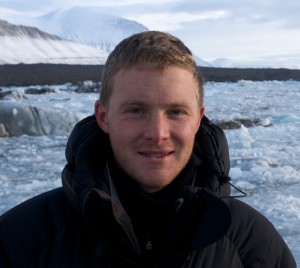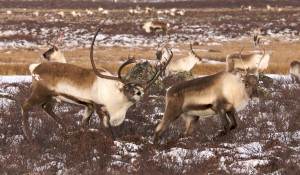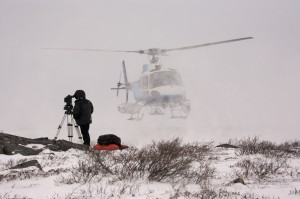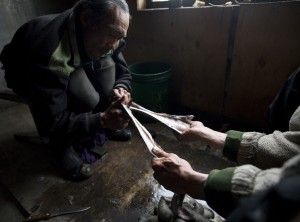WEDNESDAY, 30 NOVEMBER 2011
Winter has returned to Cambridge. We’re cursing our decisions to buy fingerless gloves rather than mittens, cycling’s become more of a chore than a joy and christmas-jumpers are around every turn. But rather than comforting ourselves with crackling fires and mulled cider down the pub, over 12 million of us have been fixated with the poles this November. We’re fixated by the wind and ice and cold, glued to the BBC iPlayer as the Natural History Unit has brought us Frozen Planet, a seven-part epic presenting “a world beyond imagination”.Recently, BlueSci caught up with one of the series’ directors Adam Scott, a Cambridge graduate, to discuss surviving in the Arctic, the culinary delights of seal meat and bringing the extremes of the world into people’s living rooms: a project that has been years in the making.
“I worked on [Frozen Planet] for two years but other people had been working on it for nearly four and that’s a big chunk of people’s lives. Finally seeing people’s reaction has been delayed gratification so it’s lovely to know people are really enjoying it. These are amazing, fascinating parts of our planet.
“There have been a lot of polar bear and penguin films in recent years and we thought we’d have to get over a bit of ‘polar-fatigue’ but what the series has done well is finding unusual stories from hidden corners of the poles that haven’t been seen before or showing familiar animals in a new way. We just needed to put the time in to find things that hadn’t been seen before”.
The enormous amount of research the Frozen Planet team put in before beginning filming obviously paid off, with the UK public being vocally amazed by footage of the least weasel plucking fur off its victim to make a blanket and the synchronized hunting techniques of killer whales (first noted by a voyaging Captain Scott, no relation). The series has even documented new animal behavious such as polar bears – generally thought to be solitary creatures – play fighting around a whale carcass, a never before seen spectacle. “That amount of social interaction and play was a big surprise even for the hardened polar bear people on the team”.
Whilst working towards a degree in archaeology and anthropology from Trinity College, Scott recalls the “incentive to carry on in academia and be an archaeologist. I’d been accepted onto a Masters course but I got cold feet and realized it was the travel and adventure that I really enjoyed. Archaeology was a great degree - we went on field trips including spending two summers in Russia but I got seduced by the world of work”.
After graduating in 2001, Scott relocated to Bristol and began working for production companies eventually finding a job with the BBC as a researcher for the critically acclaimed series Life. Over a series of ten shoots he found himself filming orangutans in Sumatra, gibbons in Thailand, and chameleons in Madagascar though throughout his travels he never found himself in the Arctic.
“A lot of [my] filming for Life had taken place in rainforests, but I discovered I quite liked the cold. As long as you have the gear, you can wrap up”. For one spectacular sequence Adam and his cameraman filmed glaciers ‘calving’ in Greenland: falling into the ocean as millions of tonnes ice edged over the coastline into open water.
“We spent two weeks there, but there were guys who spent two months down in Antarctica... In the summer [when the sun never dips below the horizon] it’s fine to walk around in a thermal top and nothing else, but when it goes bad you suddenly realize how much you need the down jackets and everything that you’ve brought”. In addition to the constant intrusion of daylight during the summer months and the every-changing, unpredictable, freezing conditions, the subjects of their filming were another ever present threat.
“When filming caribou, we knew that they were wary enough towards unfamiliar things. In that case I was working with a cameraman who had filmed caribou more than any other cameraman and knew more about them than many biologists. So in terms of knowing the animals and being able to identify their behaviour and knowing what the threats were he was the best guide to be with. But the ‘big ones’ of the series were the polar bears. The team went to Svalbard for a polar training course in February whilst it was pitch black the whole time: doing ski-doo training and working on ice, but also learning how to shoot a rifle. When you’re in Svalbard you always have someone with you with a gun as your last line of defense.
“But the local expertise and experience is always what you need. Every shoot in Svalbard had a guide who knew Svalbard and knew polar bears, who knew what the limits [of the animals] were and when to retreat and how to use flair guns if it came to that. It wasn’t taken lightly. Especially when crews out in summer [found that] the bears were more interested in them than the seals”. This problem is as old as nature documentary filming itself: how do you intimately film animals without altering the natural behaviour you want to document?
“A problem was filming animals that haven’t encountered people before. The arctic wolves with their cubs and hunting musk oxen, were totally naive. So when filming it wasn’t a problem that they’d be scared, but that they were inquisitive. [Some animals] just weren’t afraid of people, which was the case in South Georgia, where the crew were able to just walk among millions of penguins and seals”.
Much of the stunning footage from the Frozen Planet series was highly dependent on the gyroscopically-stabilized HD photography system initially developed by the BBC’s natural history for use on the Planet Earth series. In Frozen Planet this technology was adapted for filming from boats and aeroplanes at heights beyond helicopter range.
“The revolution of the stabilized camera [meant we could be] far enough above the subject that we could take steady shots and film natural behaviour. In this series the bear footage has given some of the most remarkable scenes. It’s not always obvious but they were filmed from a helicopter - such as the female suckling her cubs, the cubs playing, the males on the trail in the first program... that’s all helicopter footage, in which you’re seeing very relaxed bears showing their normal behaviour”. This technology was indispensable during one of the shoots Adam directed for the ‘Autumn’ episode - a caribou cow being relentlessly pursued by a host of would be suitors - during which the team was totally dependent on helicopter-based filming.
“The caribou were in the barren lands where there isn’t a single human footprint. So we were staying in a lodge that was 80 miles from Yellowknife [a city in Canada] on the edge of the tundra zone. So we had to fly in from Yellowknife to the lodge and everyday we’d have to find the caribou with the helicopter. We had the aerial camera on the helicopter, the aerial cameraman and myself, and Jeff who was the cameraman on the ground.
“When we found caribou we set the helicopter down some distance from them, put me and Jeff out on the ground with his kit and took the helicopter back up, so they’d film the aerials whilst we’d film from the ground.
“I think one day having finished the day’s filming we were some 70 miles from the lodge which, out there, doesn’t feel like too much - you fly home in 40 minutes over featureless tundra. It was only afterwards we realised the distances were like flying from Oxford to Bristol if you start putting things into UK scale”.
The scenes weren’t just memorable for technology used, however, but were also because of the immense amount of tireless research and patience involved in capturing them.
“We knew we wanted to be there at the time of the year when the males were rutting so we were obviously hoping for some really dramatic action with lots of clashing antlers and we had the aerial camera for the more epic shots of the herd on the move. Towards the end of the shoot we’d filmed some nice fighting and we had some great herd footage but you’re always hoping for some event that can form the core of the story.
“We were filming on the ground whilst the helicopter was overhead. We suddenly saw that there was a whole bunch of caribou running around which was not something we’d seen a lot of. We called the helicopter and said ‘have you seen what’s going on behind you?’ so they started filming and followed them for 20 minutes and as they ran straight past where we were on the ground. It wasn’t as if we planned ‘let’s go and film caribou harassing a female’ and the length of the chase was not something we’d seen a lot of: it was good fortune, but also the result of spending days and days in the field... The bulk of the job is researching stories, working out the feasibility of filming, how you and half a ton of kit are going to get there. How you’re going to live when you’re there and making sure you have everything you need for the next two weeks”.
Frozen Planet isn’t the first primetime natural history series the BBC has produced on the polar regions. 1993‘s Life in the Freezer also documented the trials of the animals living in the harshest of environments, but held the focus on Antarctica. Where Frozen Planet has built on this previous series is the way the team dispensed with the usual format of concentrating on the natural environment whilst shying away from the humans interacting with it. No doubt due to the effect the human population is having on these fragile environments, the series turns its gaze towards the people of the poles in its later episodes echoing the past success of this year’s Human Planet. Adam was on location for the walrus-hunt sequence aired in this week’s episode. “It was a fascinating place to work - we were in Chukotka which is the furthest eastern province in Russia - at the narrowest point of the Bering Sea only 50 miles from Alaska. So it was a real frontline of the Cold War, and there are still a lot of border posts and security”.
I wasn’t sure whether he would have felt conflicted, having filmed the behaviour of arctic animals in such a hands-off way to suddenly be filming a community hunting one of the most iconic arctic marine mammals. “The hunters have a tough life. 20 years ago when the Soviet Union fell apart, they were so far from anywhere else that they really had to fend for themselves when supply chains broke down, and that's when they had to rediscover the hunting traditions that had been suppressed by the Communists in favour of factory ships and collective farming, otherwise they would have starved. Today things are less harsh, but the seals and walruses they hunt, fish they catch and eggs they collect, make a significant contribution to feeding the village.
“Their hunting is very considered - they operate as well-organised cooperatives, and have strict quotas. I was seeing a lot of the species up there for the first time, and it would have been nice to have spent more time watching and filming their behaviour, but we were seeing that world through the hunters eyes. The animals suffer minimal distress and are killed quickly and cleanly. It’s as sustainable and free range as you can get. They use as much of the animals as they can - for example bearded seal skin is turned into rope for lassos, which they trade with reindeer herders. Somehow I missed out on trying the walrus meat, but I heard it was a bit like musty-tasting old bull... I did try seal which was delicious”.
In 2006 Planet Earth drew criticism from some commentators due to the lack of airtime it gave to concerns over the future of the environments it featured. Frozen Planet, in contrast, devotes an entire program (the last in the series) to the fragility of the polar ecosystems. What has resulted from four years of work is not only a series which has become must-see television, but a beautifully produced documentary that has raised awareness of just what is at stake in a place that few of us will ever manage to visit ourselves, yet which is intimately linked with our effects on the planet.
This is what television is meant for, and the BBC Natural History Unit continues to show the rest of the world just how to do it.
Written by Nick Crumpton
Ed: Episode 6 of Frozen Planet 'The Last Frontier' documenting human life in the polar regions, featuring Adam's footage from Chukotka, will be shown tonight at 9pm on BBC1. The complete series is also available to watch online through BBC iPlayer and the DVD will be released on December 8th.





